
The Ultimate Chiang Mai Neighborhood Guide for Digital Nomads and Expats

Are you a digital nomad looking for the perfect spot to live, work, and play in Chiang Mai? Look no further! Chiang Mai is rightfully known for its vibrant culture, delicious food, and affordable living. As a remote working digital nomad or expat, you need a neighborhood that offers reliable internet, comfortable workspaces, and a community of like-minded individuals. That’s why we’ve put together the ultimate Chiang Mai neighborhood guide.
From bustling Nimmanhaemin to peaceful Wat Ket, we’ve got you covered. We’ll take you on a journey through Chiang Mai’s neighborhoods, highlighting the vibe, livability, and key amenities of each. Whether you’re planning a few weeks while on the nomad trail or a long-term move, we’ll help you find your ideal neighborhood in Chiang Mai.
Overview of Chiang Mai Neighborhoods
Chiang Mai is a large province stretching 150 miles across Thailand’s northwestern mountains and valleys. A scenic drive from end to end would be about 4 hours, taking you across urban centers, rice paddies and farms, and up and down a few mountain roads.
The main urban center, known as Muang, is only about 10 km across, housing the bulk of Chiang Mai’s 1.2 million residents. You can zip across on a motorbike, even during rush hour, in less than 30 minutes.
That’s still a lot of city to cover!
We’ve kept this list a bit more focused and curated. While there are official subdistricts, we’ve created our own neighborhoods for this guide based on how many locals and long-termers think of the city. Our Chiang Mai neighborhood guide focuses on the core areas of the city center that are most popular with foreign residents, with brief notes on suburban hubs.
Without further ado, here’s an overview of the most popular neighborhoods in Chiang Mai for digital nomads and expats
Nimmanhaemin
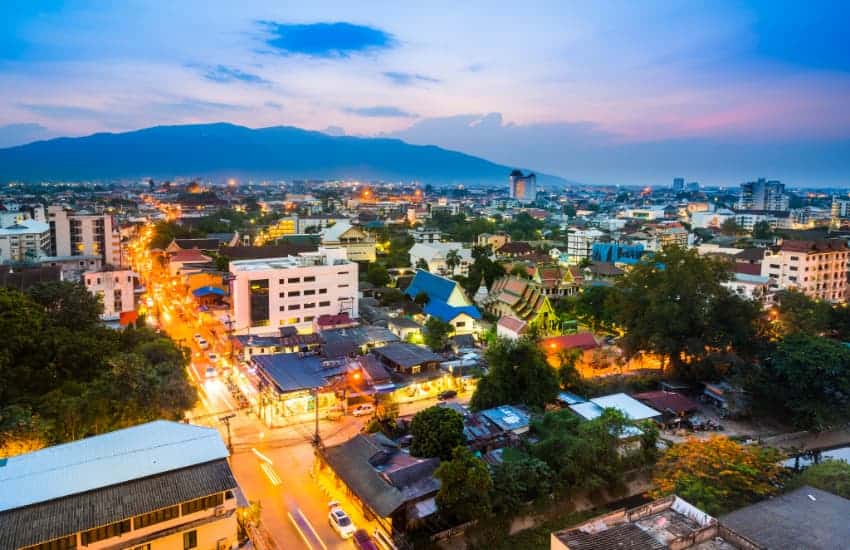
The Cosmopolitan Hub
Nimmanhaemin, or Nimman for short, is a vibrant and cosmopolitan neighborhood in the northwestern part of Chiang Mai. Once a quiet residential area, Nimman transformed into a bustling urban hub due to its proximity to Chiang Mai University. Today, it’s a thriving community filled with chic boutiques, nightlife hotspots, and a diverse food scene. Nimman’s central location makes it an excellent base for exploring other parts of the city. It’s a hotspot for digital nomads and expats seeking a dynamic blend of convenient amenities and modern Thai culture.
Within Nimman, you’ll find an array of coworking spaces like Yellow Coworking, with its posh modern amenities, and Hub 53 Coworking & Coliving space. These spaces cater to the needs of remote workers, providing high-speed internet, comfortable workstations, and networking opportunities. An abundance of coworking-friendly cafes and restaurants add to the neighborhood’s popularity with remoters.
Nimmanhaemin offers a range of mostly high-rise housing options. Take your pick from the many serviced apartments and luxury condos – you’ll also find unique homes and villas via Airbnb. You can best explore Nimman on foot, but the sidewalks do leave much to be desired. Parking in this neighborhood is abysmal, so a motorbike ought to be your ride of choice. Between the nightlife and the nearby airport, this neighborhood is one of Chiang Mai’s noisiest.
Santitham
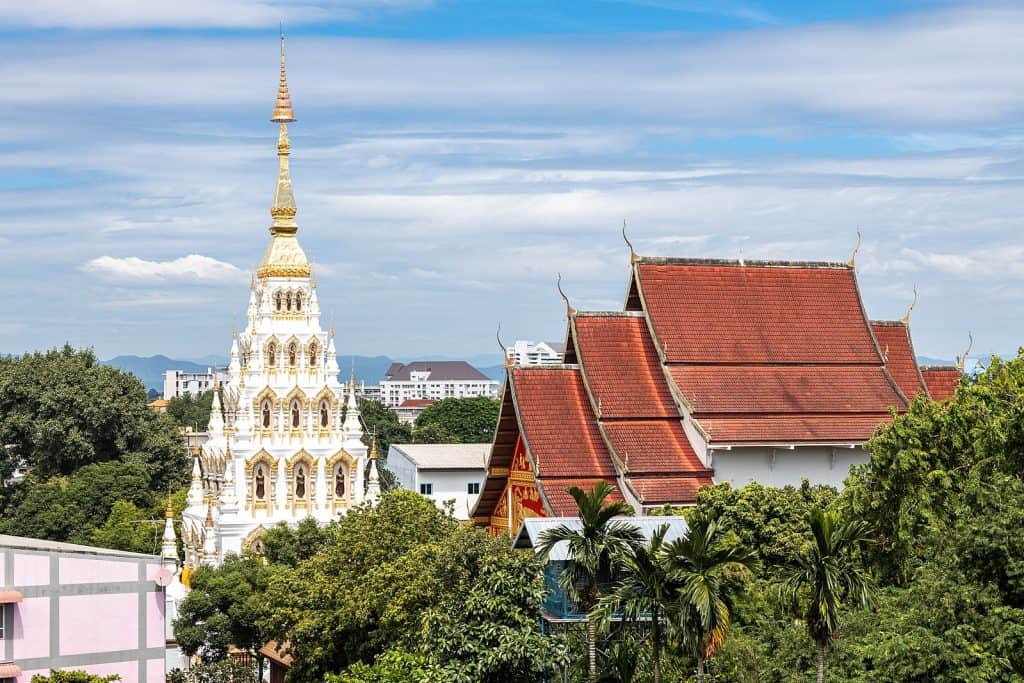
The Up-and-Coming Neighborhood
Adjacent to Nimmanhaemin and just northwest of the Old City lies Santitham, an up-and-coming area popular among digital nomads for its affordability and authentic Thai-ness. With multi-story shophouses lining its streets, Santitham exudes a vibrant atmosphere. While affordable living costs attract both local Thais and visitors, modern condos and coworking spaces cater to international standards.
Santitham offers a range of coworking spaces to choose from. Ombra Cafe and Akha Ama are known for providing excellent work environments. For a more comprehensive coworking experience, One Coworking, bordering Santitham and Chang Puak, offers a well-rounded set of amenities.
Santitham predominantly features multi-story shophouses converted into cafes and restaurants, making it ideal for those seeking affordable and quaint living. Houses are scarce, but there are some great condos in this neighborhood, like D Vieng. It’s walkable, but a motorbike is recommended for greater convenience.
Old City
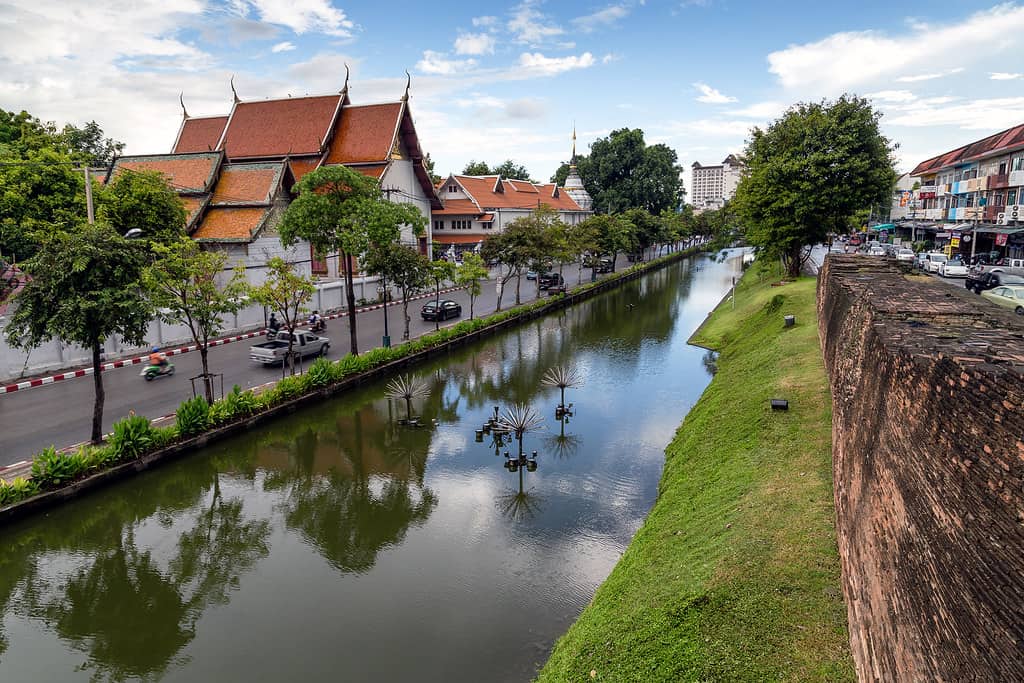
The Historic Heart of Chiang Mai
The Old City is the historic heart of Chiang Mai, surrounded by a moat and ancient walls. It’s a place where beautiful temples, museums, and cultural attractions harmoniously coexist with 7-Elevens and luxury spas. This charming blend of old and new, low-brow and hi-so, contributes to the Old City’s unique appeal. It’s a highly developed area that remains culturally rich, making it an excellent choice for those seeking history and modern convenience.
Alt_Chiang Mai, tucked behind Wat Pra Singh on a quiet street leading to the moat, is a fantastic coliving and coworking space in the Old City. It offers excellent amenities and keeps a busy schedule of lifestyle and entrepreneurial events for the community. You can also cowork at one of Punspace’s two Old City coworking spaces.
The Old City mainly offers smaller guesthouses and budget apartments, but you’ll also find charmingly renovated houses within its ancient walls. It’s highly walkable and easily explored by bicycle if you’re not yet ready for the thrills of a motorbike.
Chang Puak
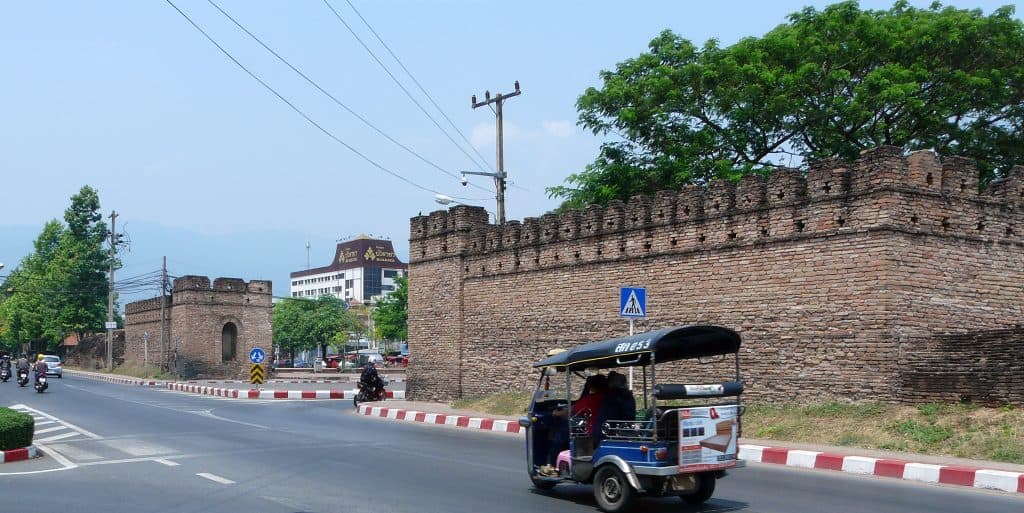
The Sprawling Northern Enclave
Chang Puak, extending from the moat and Chiang Mai’s North Gate to the surrounding Superhighway, is characterized by its proximity to Rajaphat University campus and bustling Tanin Market. It’s a diverse neighborhood offering a mix of local life and modern conveniences. Along the riverside, it blends into Chang Moi, where the famous Warorot Market is located.
Chang Puak boasts a variety of housing options at reasonable rates, making it an attractive choice for those on a budget. While the neighborhood doesn’t have a wealth of coworking spaces, its central location allows easy access to nearby coworking hubs in Santitham, Nimmanhaemin, and the Old City.
Chang Puak features diverse housing options, from apartments to townhouses, suitable for those on a budget. It’s best explored by motorbike, allowing easy access to surrounding areas.
Chang Moi
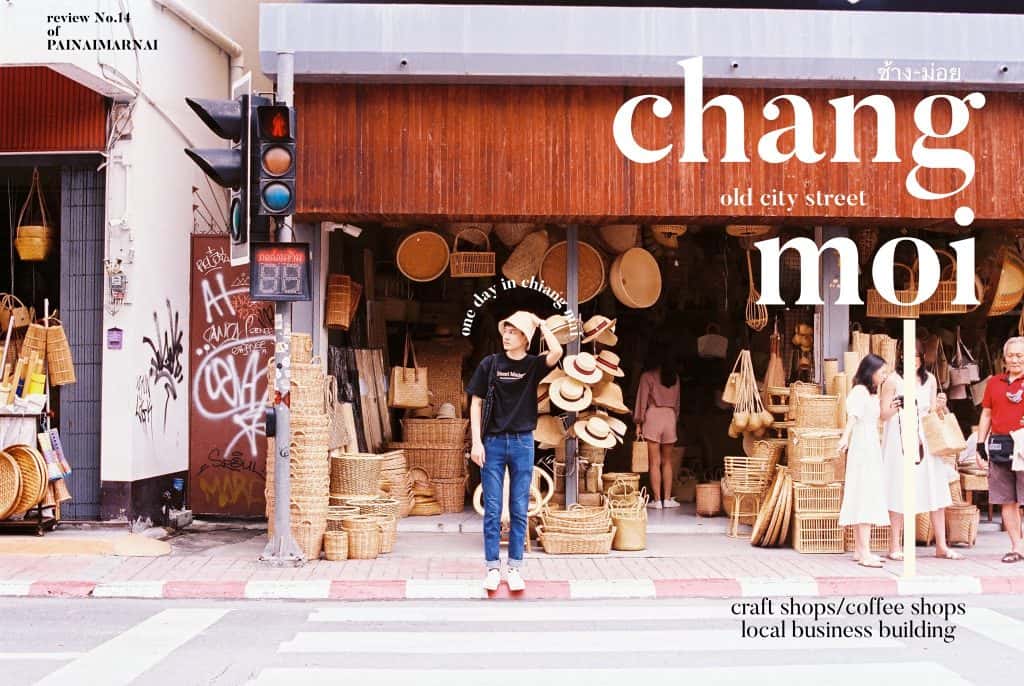
Chiang Mai’s Old Hub of Commerce and New Center Culture
Chang Moi is a bustling neighborhood that extends from the eastern edge of the Old City to the banks of the Ping River. It’s known for vibrant commerce and rich cultural experiences. The area hosts the lively Warorot Market, where locals and tourists alike shop for fresh produce, clothing, and traditional Northern Thai products. Here you’ll also find Chiang Mai’s Chinatown. This neighborhood is perfect for those who want to be at the heart of Chiang Mai’s hip urban revival.
While Chang Moi doesn’t have many dedicated coworking hubs, the neighborhood’s bustling atmosphere invites remote workers to set up in the numerous local cafes. Don’t skip The Story 106, which has a cafe and crafts shop downstairs and a beautifully decorated coworking zone upstairs.
Chang Moi’s housing options may be more limited than in other areas – it has more hotels and guesthouses than condos and homes suitable for extended stays. This neighborhood is super walkable, but motorbikes offer greater flexibility for exploring beyond its bustling bounds.
Chang Klan
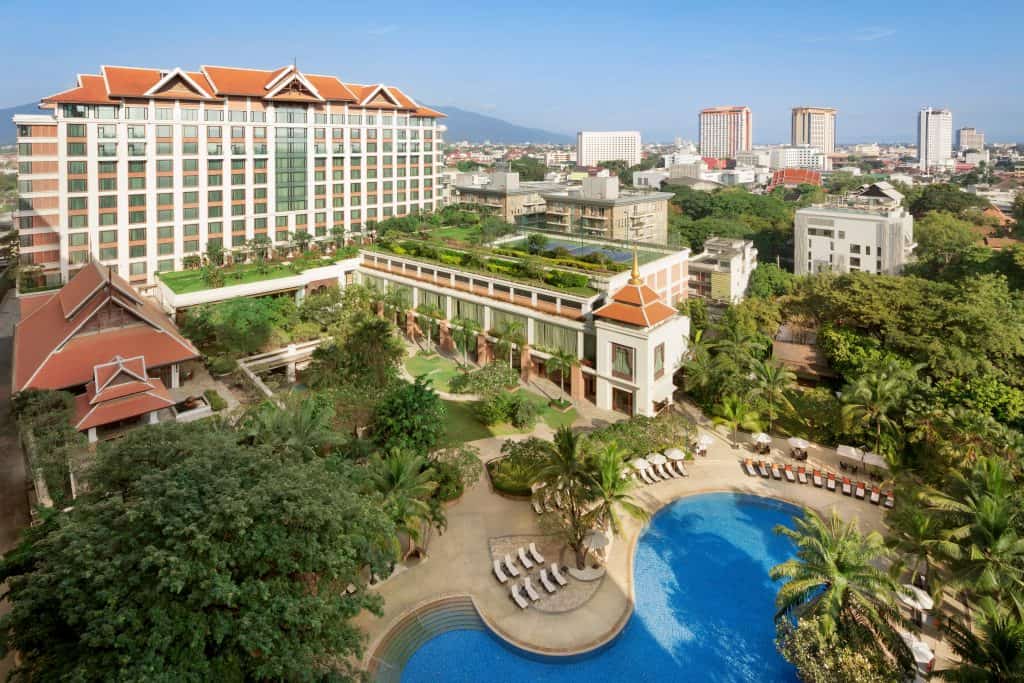
Central Location with a Slightly Upscale Feel
Chang Klan is a district with an odd mix of upscale and rundown. This part of town was really emptied by the pandemic, but it’s home to luxury hotels, high-rise condos, and international restaurants, making it a top choice for affluent digital nomads. The area also boasts the famous Night Bazaar, where you can shop for handicrafts and savor local delicacies.
In Chang Klan, you’ll find a handful of cafes and bars where you can work remotely, but Starbucks is probably your best choice. The lone coworking space in the ‘hood is Heartwork, the Sharing Space. Additionally, some upscale hotels in the area provide quiet and comfortable spaces for digital nomads to get work done while enjoying more opulent surroundings.
Chang Klan features luxury hotels, high-rise condos, and upscale apartments. It’s well-suited for walking, but many residents prefer motorbikes for quick access to nearby attractions.
Wat Ket Riverside
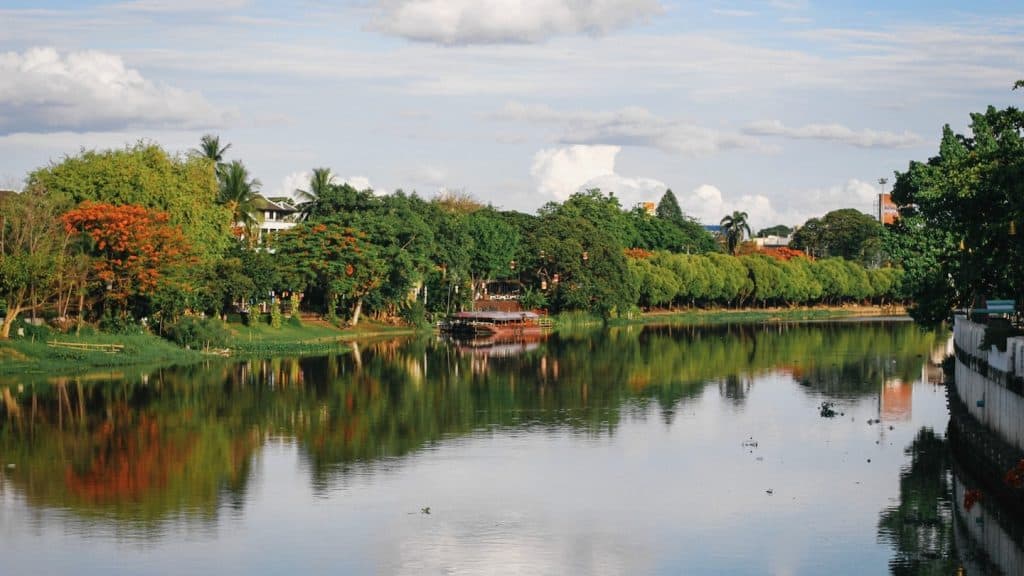
Chiang Mai’s Original Expat Neighborhood
Located along the banks of the Ping River, Wat Ket Riverside holds historical significance as Chiang Mai’s original expat hub. Missionaries were granted land here, and the neighborhood is home to Chiang Mai’s oldest church. It’s a place where traditional shophouses, historic venues, and a vibrant arts, dining, and nightlife coexist. With its rich history and many landmarks, Wat Ket Riverside offers a highly cultural living experience.
Wat Ket Riverside boasts a serene environment but has not typically been the top choice for remoters. The tranquility along the riverbanks provides a peaceful alternative to areas typically favored by nomads, but the addition of Alt_Ping River Coliving & Coworking has brought this ‘hood into the heart of the city’s remote work scene. Be sure to visit Anusarn Sanpakoi which is a commercial complex at the heart of the area’s cultural revival.
Wat Ket Riverside offers a mix of older but usually well-maintained high-rise condos and residential houses. It’s walkable right along the Ping River but best explored by motorbike due to its spread. Cars may have trouble finding parking.
Hai Ya
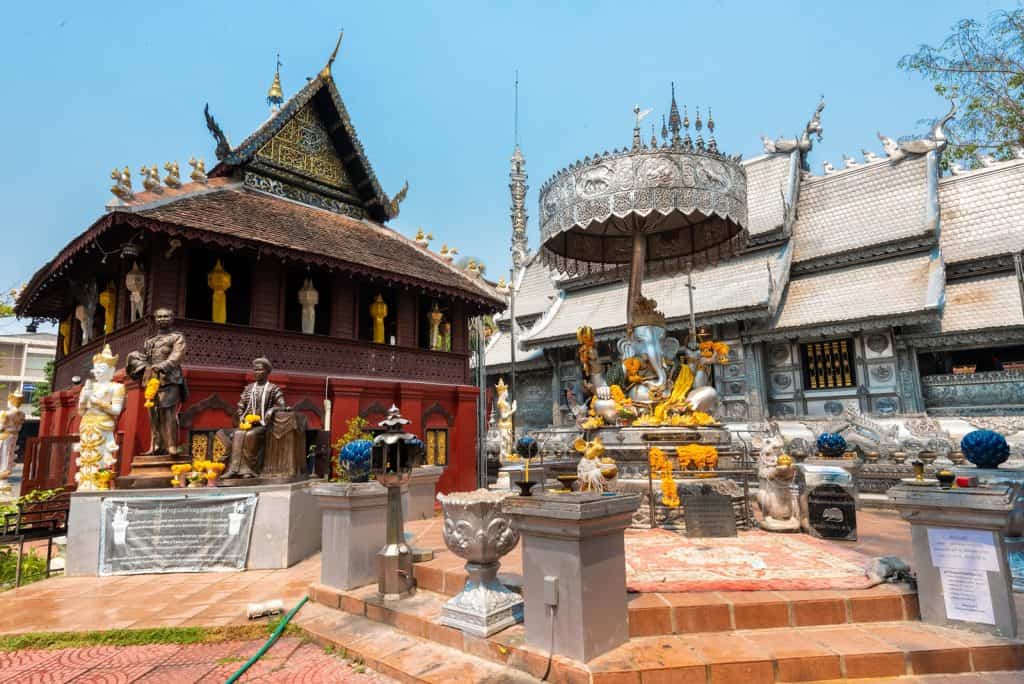
The Local's Favorite
Hai Ya, bordering the Old City, Chang Klan, and Mahidol Road, is close to Chiang Mai International Airport. Its central location provides easy access to key city attractions. Hai Ya is known for its mix of major commercial roads and winding neighborhood streets. You can get a little bit of everything in Hai Ya. Notably, Wua Lai Road here hosts the vibrant Saturday market, which starts at the Old City’s southern Chiang Mai Gate and veins its way down.
A downside of Hai Ya is a lack of coworking spaces, but as everywhere else in Chiang Mai, cafes and restaurants are typically laptop-friendly. Do check out Weave Artisan Society. This venue has a cafe, craft beer bar, chocolaterie, barbecue restaurant, art gallery, and more inside a funky converted warehouse space. We’ll also shamelessly plug our friend Charlotte’s new photography studio, which is definitely going to become a local hub for creativity and entrepreneurship.
Hai Ya offers a mix of housing, including apartments and local-style homes. It’s walkable-ish but more bicycle or motorbike-friendly. Fair warning, this area is prone to flooding so be prepared if signing a long-term lease or perhaps pick a different part of town to stay in if you’re visiting during the rainy season (check our seasonal guide to visiting Chiang Mai for more pointers).
Suan Dok
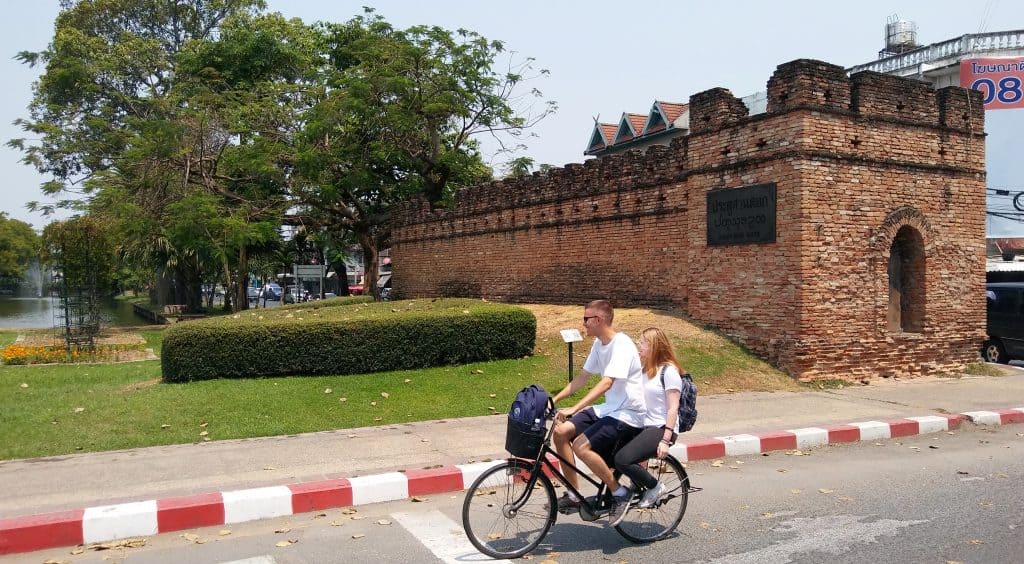
The Peaceful Urban Oasis
The Peaceful Urban Oasis
Practically hidden right in the middle of Chiang Mai, Suan Dok is a hidden gem nestled between Nimman, the Old City, and the Canal Road (Suthep). Dominated by the serene Suan Dok Temple, this charming neighborhood offers a peaceful retreat with its mix of residential houses and modern condos tucked away in its quiet streets. Its strategic location provides residents with the best of both worlds: the vibrant energy of Nimman, the historical allure of the Old City, and the lush green surroundings of Suthep. Suan Dok strikes a harmonious balance between urban convenience and natural beauty, making it an attractive choice for those seeking a tranquil yet well-connected neighborhood in Chiang Mai.
Nearby Nimman and the Old City are your best options for nearby coworking, but within this small neighborhood, you also have places like the Barn Eatery and Cafe, which are very coworking-friendly.
Suan Dok boasts a diverse range of housing options, from modern condominiums to traditional-style homes. Keep in mind that Suan Dok is right below the airport’s flight path, so it can be noisy with take-offs and landings.
Suthep (“Langmor”)
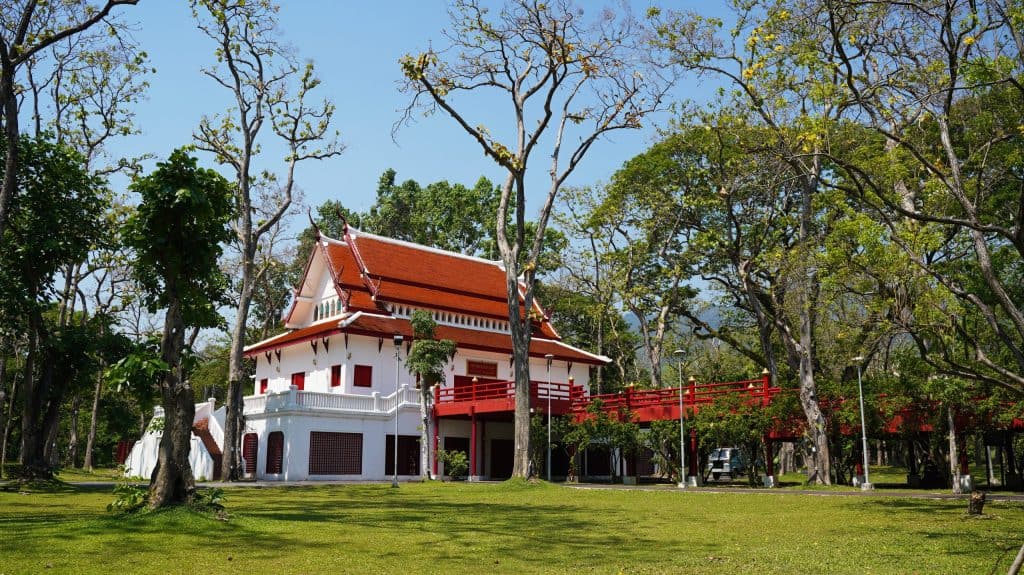
The Student's Choice
Suthep, often referred to as Langmor, is a neighborhood favored by students due to its proximity to Chiang Mai University. It’s a lively area with affordable housing options and a vibrant atmosphere. The presence of students adds to its energetic vibe, making it an excellent choice for those seeking affordability and a youthful community.
Suthep hosts a variety of student-friendly cafes, but mind that the workspaces often fill up. Be sure to check out Blue Cafe & Coworking on campus. Additionally, a few coworking spaces in neighboring Nimmanhaemin are easily accessible from Suthep. Don’t miss the nightly food market that pops up at the edge of campus!
Suthep offers a range of budget-friendly housing, including student dorms and affordable apartments. It’s relatively walkable, but you’ll probably want to rent a motorbike if you’re staying here for long.
Pong Noi
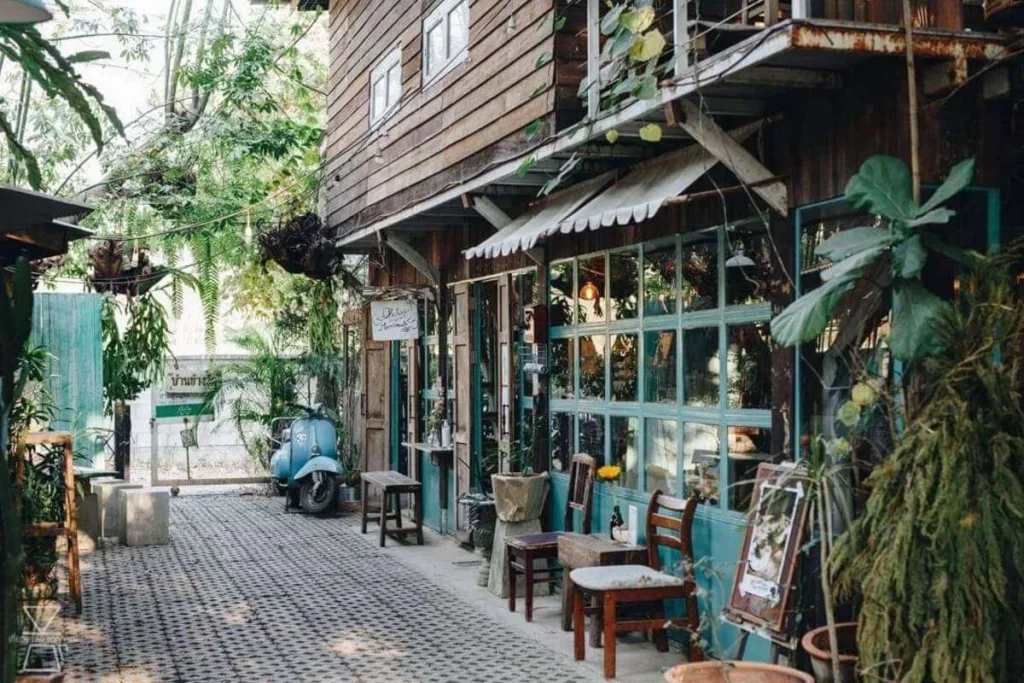
For the Artsy and Spiritual
Flowing from Langmor and anchored by three temples along Wat Umong Soi 4, Pong Noi is a hidden gem for digital nomads and expats. Abutting Doi Suthep, this area is typically greener and cooler than much of the city. Wat Umong and Wat Rampoeng are popular meditation centers, so the area often attracts a spiritual crowd. It’s also a neighborhood teeming with artsy craft venues and community-oriented markets like Lansiew, Baan Kang Wat, and Laan Din.
Pong Noi’s creative and communal spirit extends to its workspaces, local cafes often double as cozy coworking spots. We recommend Crate Cafe, Sensations Coffee, and Pate a Choux as particularly work-friendly.
Pong Noi boasts a mix of houses and condos, catering to both students and creative souls. There is a surprising amount of housing tucked away down many dead-end sois. While the main road through this neighborhood is crowded at times, it’s accessible by motorbike and car for convenient travel. Plenty of people walk and cycle around here but be prepared to share the road.
Jed Yod
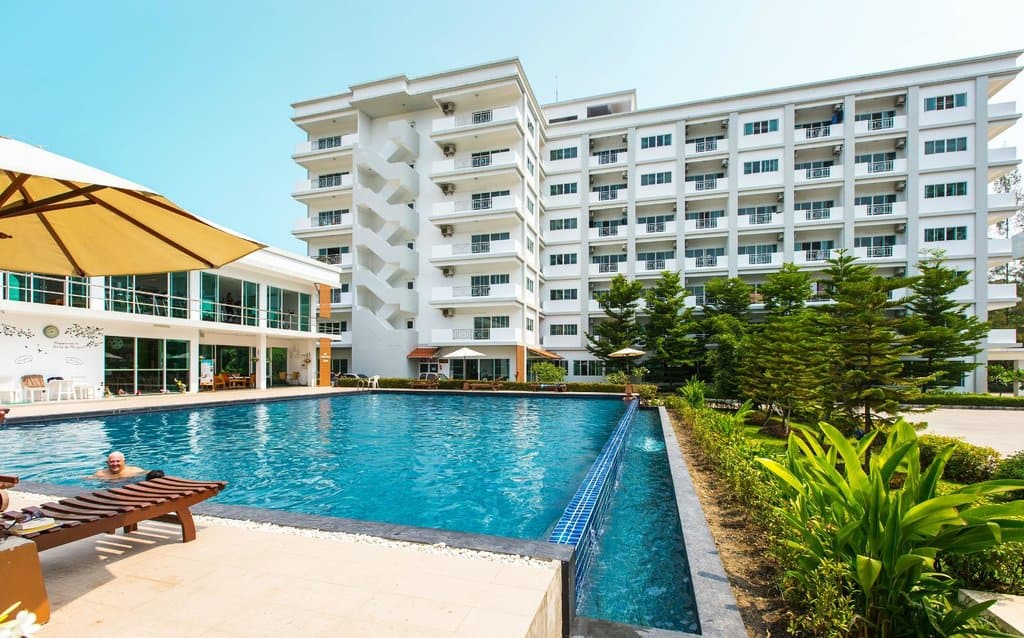
The Hub Between Highways
Jed Yod is a neighborhood squeezed between the Canal Road and the Superhighway, making it an ideal choice for those who value accessibility. Its affordability and proximity to other desirable neighborhoods make it a popular area for digital nomads. With a mix of condos, houses, and local businesses, Jed Yod offers an authentic living experience in Chiang Mai.
This area is a favored hub for those who want the convenience of Nimmanhaemin without the associated price tag. Popular coworking space CAMP and Maya Mall are thought of as being in Nimman, but are technically in Jed Yod. If you’re exploring this part of town, don’t miss The Coco Club, a gorgeous beach club style coworking space, and you’ll want to visit 7 Pounds for music and drinks.
Jed Yod provides affordable condos and houses, ideal for those looking for budget-friendly living. Its exceptionally narrow streets are best navigated by motorbike. Keep in mind that this neighborhood experiences some of the worst airplane noise – it’s right underneath where departing airplanes make a turn above the city.
Chang Khian
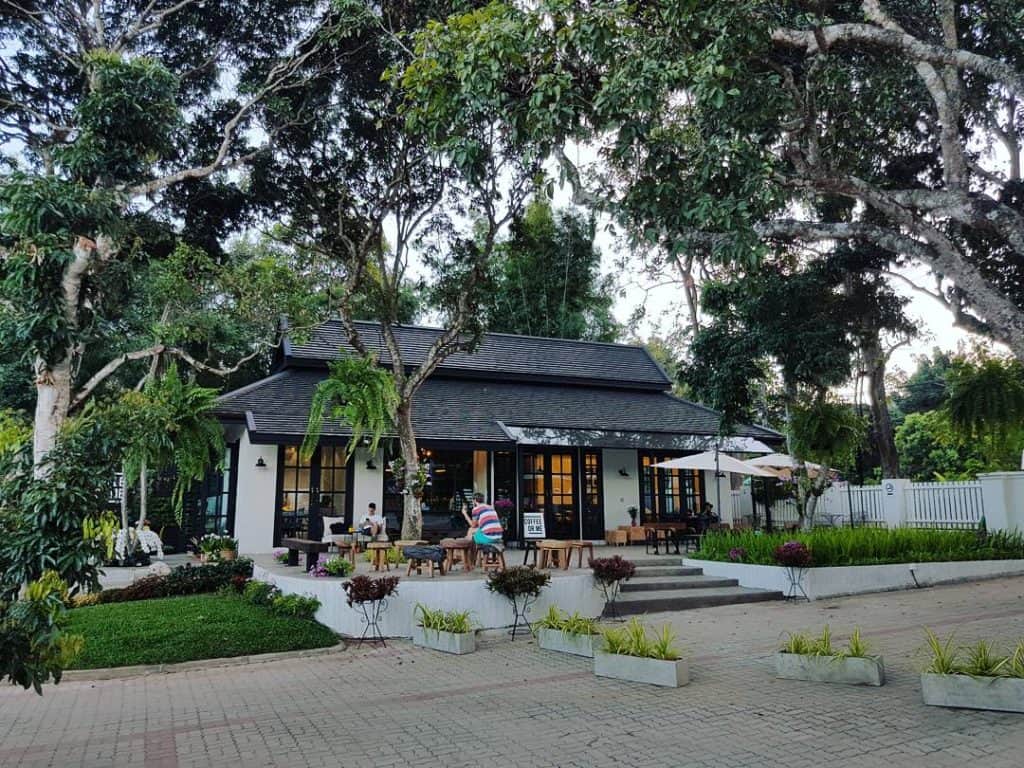
The Nature Lover’s Paradise
Chang Khian, nestled against the mountains and abutting CMU campus and the Chiang Mai Zoo, is a paradise for nature lovers. This neighborhood stretches aaaallllll the way down to Cafe de Oasis and the Chiang Mai International Exhibition and Convention Centre. The area offers lush greenery, serene streets, and access to a handful of hiking trails. While it may not have the bustling nightlife of other neighborhoods, it has many nice cafes and restaurants and provides a peaceful retreat for those who prefer a closer connection to nature.
While there are no dedicated coworking spaces in this neighborhood, the cafes are often quiet and spacious enough for you to post up with your laptop.
Chang Khian offers a mix of houses and condos amidst lush greenery. It’s a haven for nature lovers and is best explored by motorbike.
Chiang Mai’s Suburban Areas
So far, this guide to Chiang Mai’s neighborhoods is comprehensive but stays within the city’s urban limits. The city has grown and grown into the surrounding province, and there are many neighborhoods beyond the bounds of the Canal Road, Superhighway, and Ping River that we have mainly concentrated on.
Within the “Muang” district of Chiang Mai, there are several suburban neighborhoods and popular residential zones favored by expat families for their quieter ambiance and family-friendly amenities.
Saraphi, located to the south of Chiang Mai, is characterized by its tranquil surroundings and a variety of housing choices, including spacious homes and gated communities. This suburban neighborhood attracts families looking for a peaceful living environment while remaining close to the city.
Central Festival, a giant shopping mall marks the intersection of Highway 1001 (also known as Chiang Mai – Lamphun Road) and Highway 121 (also known as Nong Pa Khrang Road). These roads run from the city center to major outlying areas, and a number of luxury superhigh-rise condos can be found at this junction.
Tha Sala, nestled along the Ping River east of the Old City, offers a suburban setting with a local flavor. Known for its riverfront residences and peaceful surroundings, Tha Sala is a favored choice among families seeking a tranquil living environment.
Fa Ham is a residential area situated west of the Old City, offering a mix of housing options from traditional-style homes to modern condominiums. Its convenience and proximity to the city center make it a suitable choice for families.
Nong Hoi, positioned to the southeast of the Old City, provides a range of housing options for families, including apartments and houses. Its accessibility to local amenities and schools makes it an appealing residential zone for expat families seeking convenience and comfort.
Mae Hia lies to the southwest of the Old City and is known for its quiet neighborhoods. It boasts a variety of housing options, including homes with gardens and gated communities. The area is conveniently close to Mae Hia Market, the Chiang Mai Night Safari, and provides easy access to the Hang Dong district.
Further out from the city center, expat families often prefer these popular residential zones:
Hang Dong, to the south of Chiang Mai, provides a suburban lifestyle with a range of housing options, including spacious houses and gated communities. It’s recognized for its international schools and serene surroundings.
Nam Phrae, located further south of Chiang Mai, is known for its tranquil rural ambiance and spacious residences, providing a quiet retreat for families seeking a peaceful living environment.
Mae Rim, situated north of Chiang Mai, is known for its picturesque landscape and natural beauty. Families are drawn to Mae Rim for its lush greenery, upscale housing choices, and proximity to attractions like the Mae Sa Valley and Queen Sirikit Botanic Garden.
Mae Jo, located north of the city, offers a suburban haven with lush greenery and open spaces. It’s a preferred choice for families due to its serene environment and proximity to institutions like Mae Jo University. Housing options encompass modern homes and traditional-style houses.
Sansai, situated to the northeast of Chiang Mai, offers a serene suburban lifestyle with a mix of traditional and modern housing options, making it a peaceful choice for expat families.
Doi Saket, east of Chiang Mai, offers a rural and tranquil living experience. Families appreciate the spacious properties, countryside vistas, and peaceful ambiance. While it’s a bit farther from the city center, Doi Saket provides a serene retreat.
Choosing the Perfect Neighborhood for Your Stay in Chiang Mai
As you explore these diverse Chiang Mai neighborhoods, consider your preferences for culture, convenience, and community. Each district offers a unique living experience, and your choice depends on whether you seek history, affordability, nature, or modern amenities. Ultimately, Chiang Mai’s neighborhoods cater to a variety of lifestyles, making it easier for digital nomads and expats to find their ideal spot in this captivating city.
Conclusion
Chiang Mai is an ideal destination for digital nomads looking for a vibrant culture, affordable living, and a thriving community of like-minded individuals. With its reliable internet connection, coworking spaces, and cafes, Chiang Mai offers everything a digital nomad needs to stay connected and productive. By following this guide, you can find the perfect spot to live in Chiang Mai, whether you prefer a lively atmosphere or a quiet retreat.